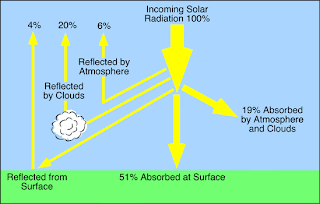Bioluminescence is light produced by a chemical reaction within an organism. The protein which produces the light is generically called luciferin and the enzyme that catalyzes the reaction is called luciferase. The luciferase catalyzes the oxidation of luciferin resulting in light and an inactive oxyluciferin. In most cases, fresh luciferin must be brought into the system, either through the diet or by internal synthesis.
Sometimes the luciferin and luciferase as well as a co-factor such as oxygen, are bound together to form a single unit called a photoprotein. This molecule can be triggered to produce light when a particular type of ion (frequently Calcium)is added to the system .
Bioluminescence is not the same as "fluorescence" or "phosphorescence". In bioluminescence or chemiluminescence the excitation energy is supplied by a chemical reaction rather than from a source of light.
FluorescenceIn fluorescence, energy from a source of light is absorbed and reemitted as another photon. Fluorescence does not occur in complete darkness.
- An electron (yellow) "orbits" the nucleus (blue), minding its own business.
- A source of light of an appropriate wavelength (indicating its energy) strikes.
- It drives the electron into a higher-energy orbital.
- The electron is only stable there for a short time.
- Shortly it returns to the lower energy level.
- This way it emits the energy as a longer wavelength photon.
- The electron continues on its way.
Due to energy loss while in the excited state, the photon emitted will always be of longer wavelength (more red, lower energy) than the exciting photon. This is how laundry detergents can get things "whiter than white": by absorbing non-visible UV light and fluorescing in the visible spectrum.
PhosphorescencePhosphorescence is similar to fluorescence except that the excited product is more stable, so that the time until the energy is released is much longer, resulting in a glow after the light has been removed. This is the basis behind glow-in-the-dark stickers.
ChemiluminescenceChemiluminescence is a general term for production of light when the excitation energy has come from a chemical reaction (as opposed to the absorption of photons, in fluorescence).
Bioluminescence is a subset of chemiluminescence, where the light-producing chemical reaction occurs inside an organism.
Types of LuciferensThere are few basic luciferins (light emitters).
Post your comments. To learn how to post comments click here.
















